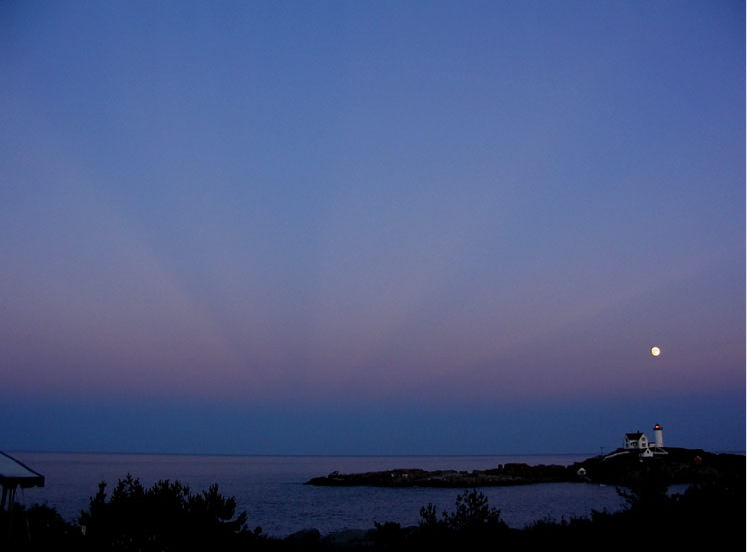Anticrepuscular Rays - Nubble Light, York Beach, Maine
Anticrepuscular Rays: A Spectacular Phenomenon at Nubble Light, York Beach, Maine
Nubble Light near York Beach, Maine, is renowned for its breathtaking views, and on a particular evening, photographer Steve Kluge captured a mesmerizing scene. As the night sky emerged, Kluge witnessed an extraordinary display of atmospheric optics known as anticrepuscular rays. These captivating rays of light and dark appeared to converge near the horizon, creating a truly enchanting spectacle.
The formation of anticrepuscular rays is attributed to a combination of factors that unfolded that evening. A gentle sea breeze had swept in earlier in the day, causing the warm land behind to release pockets of rising air. These rising air currents gave birth to scattered cumulus clouds that began to dot the sky.
The darker areas within the anticrepuscular rays are, in fact, the parallel shadows cast against the sky by the setting sun. As the sun dipped below the horizon, the perspective from Nubble Light caused these shadows to converge at the anti-solar point in the sky. This convergence created a visually striking effect that added to the allure of the scene.
Adding to the ethereal ambiance was the "Belt of Venus," a band of pink sky that seemed to cradle the almost full moon. This celestial phenomenon occurs when the last remnants of sunlight illuminate the upper atmosphere, casting a reddish hue on the sky. Just below the Belt of Venus, the dark sky of Earth's shadow began to rise, further enhancing the contrasting colors and captivating reflections on the water's surface.
The beauty of anticrepuscular rays lies in their rarity and evanescent nature. Observing such a phenomenon requires a combination of specific atmospheric conditions, including the presence of cumulus clouds, an unobstructed view towards the anti-solar point, and a keen eye to spot these subtle displays of light and shadow.
It is important to note that anticrepuscular rays are often mistaken for their more well-known counterparts, crepuscular rays. While both phenomena share similarities, anticrepuscular rays appear to converge at the anti-solar point, whereas crepuscular rays radiate outward from the sun.
Anticrepuscular rays are not limited to a specific location or time of year. They can occur anywhere on Earth, provided the atmospheric conditions are favorable. However, witnessing this phenomenon at Nubble Light in York Beach, Maine adds an extra touch of magic to the experience.
Photographers and nature enthusiasts flock to Nubble Light, drawn by its picturesque setting and the potential for capturing stunning images. The combination of the historic lighthouse, the rugged coastline, and the possibility of witnessing atmospheric optics phenomena such as anticrepuscular rays make it a truly captivating destination.
In conclusion, Steve Kluge's photograph of anticrepuscular rays at Nubble Light in York Beach, Maine provides a glimpse into the awe-inspiring beauty of atmospheric optics. This captivating phenomenon, characterized by converging rays of light and shadow, creates a surreal and enchanting spectacle in the night sky. By understanding the scientific principles behind anticrepuscular rays and being aware of the specific atmospheric conditions required for their occurrence, we can appreciate the rarity and wonder of these natural phenomena. Nubble Light serves as the perfect backdrop for witnessing such celestial displays, adding to its allure as a must-visit destination for those seeking a truly magical experience.

Maine Anticrepuscular Rays
Steve Kluge took the image and he describes the scene..
"We .were on. the southern coast of Maine where we were treated to an incredible view of the rising nighttime sky over Nubble Light near York Beach.
A nice sea breeze had developed earlier in the day, and a small scattering of cumulus clouds developed in the air rising over the warm land behind us.
The rays of light and dark that appear to converge near the horizon are anticrepuscular rays, the darker areas are actually the parallel shadows of those clouds cast against the sky by the setting sun. Perspective causes the apparent convergence at the anti-solar point in the sky.
The band of pink sky that the almost full moon seems to float on is called the "Belt of Venus", and it is the last bit of sky to be lit by the red rays of the sun. Just below the Belt, the dark sky of the Earth's shadow is rising, and both aspects are nicely reflected off the water, too! "
Image ©Steve Kluge, shown with permission.
Note: this article has been automatically converted from the old site and may not appear as intended. You can find the original article here.
Reference Atmospheric Optics
If you use any of the definitions, information, or data presented on Atmospheric Optics, please copy the link or reference below to properly credit us as the reference source. Thank you!
-
<a href="https://atoptics.co.uk/blog/anticrepuscular-rays-nubble-light-york-beach-maine/">Anticrepuscular Rays - Nubble Light, York Beach, Maine</a>
-
"Anticrepuscular Rays - Nubble Light, York Beach, Maine". Atmospheric Optics. Accessed on November 26, 2024. https://atoptics.co.uk/blog/anticrepuscular-rays-nubble-light-york-beach-maine/.
-
"Anticrepuscular Rays - Nubble Light, York Beach, Maine". Atmospheric Optics, https://atoptics.co.uk/blog/anticrepuscular-rays-nubble-light-york-beach-maine/. Accessed 26 November, 2024
-
Anticrepuscular Rays - Nubble Light, York Beach, Maine. Atmospheric Optics. Retrieved from https://atoptics.co.uk/blog/anticrepuscular-rays-nubble-light-york-beach-maine/.